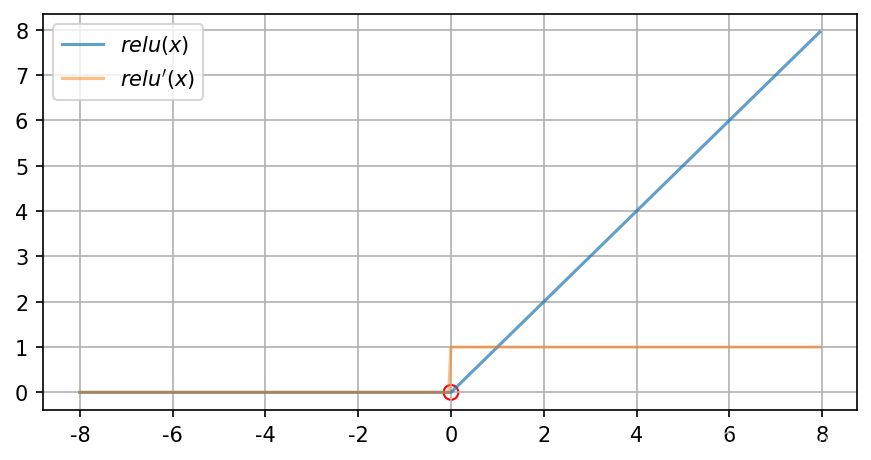文章目錄
- ReLu
- 公式
- 求導過程
- 優點:
- 缺點:
- 自定義ReLu
- 與Torch定義的比較
- 可視化
- Leaky ReLu PReLu
- 公式
- 求導過程
- 優點:
- 缺點:
- 自定義LeakyReLu
- 與Torch定義的比較
- 可視化
- 自定義PReLu
- ELU
- 公式
- 求導過程
- 優點
- 缺點
- 自定義LeakyReLu
- 與Torch定義的比較
- 可視化
import matplotlib
import matplotlib.pyplot as plt
import numpy as np
import torch
import torch.nn as nn
import torch.nn.functional as F%matplotlib inlineplt.rcParams['figure.figsize'] = (7, 3.5)
plt.rcParams['figure.dpi'] = 150
plt.rcParams['axes.unicode_minus'] = False #解決坐標軸負數的鉛顯示問題
ReLu
線性整流函數 (rectified linear unit)
公式
relu=max?(0,x)={x,x>00,x≤0\text{relu} = \max(0, x) = \begin{cases} x, &x>0 \\ 0, &x\leq 0 \end{cases}relu=max(0,x)={x,0,?x>0x≤0?
求導過程
f(x)是連續的f(x)是連續的f(x)是連續的
f′(x)=lim?h→0f(0)=f(0+h)?f(0)h=max?(0,h)?0hf'(x)=\lim_{h\to 0}f(0) = \frac{f(0 + h)-f(0)}{h}=\frac{\max(0, h) - 0}{h}f′(x)=limh→0?f(0)=hf(0+h)?f(0)?=hmax(0,h)?0?
lim?h→0?=0h=0\lim_{h\to0^-}=\frac{0}{h} = 0limh→0??=h0?=0
lim?h→0+=hh=1\lim_{h\to0^+}=\frac{h}{h} = 1limh→0+?=hh?=1
所以f′(0)f'(0)f′(0)處不可導
所以f′(x)={1,x>00,x<0f'(x) = \begin{cases} 1, & x > 0 \\ 0, & x < 0 \end{cases}f′(x)={1,0,?x>0x<0?
優點:
ReLU激活函數是一個簡單的計算,如果輸入大于0,直接返回作為輸入提供的值;如果輸入是0或更小,返回值0。
- 相較于sigmoid函數以及Tanh函數來看,在輸入為正時,Relu函數不存在飽和問題,即解決了gradient vanishing問題,使得深層網絡可訓練
- Relu輸出會使一部分神經元為0值,在帶來網絡稀疏性的同時,也減少了參數之間的關聯性,一定程度上緩解了過擬合的問題
- 計算速度非常快
- 收斂速度遠快于sigmoid以及Tanh函數
缺點:
- 輸出不是zero-centered
- 存在Dead Relu Problem,即某些神經元可能永遠不會被激活,進而導致相應參數一直得不到更新,產生該問題主要原因包括參數初始化問題以及學習率設置過大問題
- ReLU不會對數據做幅度壓縮,所以數據的幅度會隨著模型層數的增加不斷擴張,當輸入為正值,導數為1,在“鏈式反應”中,不會出現梯度消失,但梯度下降的強度則完全取決于權值的乘積,如此可能會導致梯度爆炸問題
自定義ReLu
class SelfDefinedRelu(torch.autograd.Function):@staticmethoddef forward(ctx, inp):ctx.save_for_backward(inp)return torch.where(inp < 0., torch.zeros_like(inp), inp)@staticmethoddef backward(ctx, grad_output):inp, = ctx.saved_tensorsreturn grad_output * torch.where(inp < 0., torch.zeros_like(inp),torch.ones_like(inp))class Relu(nn.Module):def __init__(self):super().__init__()def forward(self, x):out = SelfDefinedRelu.apply(x)return out
與Torch定義的比較
# self defined
torch.manual_seed(0)relu = Relu() # SelfDefinedRelu
inp = torch.randn(5, requires_grad=True)
out = relu((inp).pow(3))print(f'Out is\n{out}')out.backward(torch.ones_like(inp), retain_graph=True)
print(f"\nFirst call\n{inp.grad}")out.backward(torch.ones_like(inp), retain_graph=True)
print(f"\nSecond call\n{inp.grad}")inp.grad.zero_()
out.backward(torch.ones_like(inp), retain_graph=True)
print(f"\nCall after zeroing gradients\n{inp.grad}")
Out is
tensor([3.6594, 0.0000, 0.0000, 0.1837, 0.0000],grad_fn=<SelfDefinedReluBackward>)First call
tensor([7.1240, 0.0000, 0.0000, 0.9693, 0.0000])Second call
tensor([14.2480, 0.0000, 0.0000, 1.9387, 0.0000])Call after zeroing gradients
tensor([7.1240, 0.0000, 0.0000, 0.9693, 0.0000])
# torch defined
torch.manual_seed(0)
inp = torch.randn(5, requires_grad=True)
out = torch.relu((inp).pow(3))print(f'Out is\n{out}')out.backward(torch.ones_like(inp), retain_graph=True)
print(f"\nFirst call\n{inp.grad}")out.backward(torch.ones_like(inp), retain_graph=True)
print(f"\nSecond call\n{inp.grad}")inp.grad.zero_()
out.backward(torch.ones_like(inp), retain_graph=True)
print(f"\nCall after zeroing gradients\n{inp.grad}")
Out is
tensor([3.6594, 0.0000, 0.0000, 0.1837, 0.0000], grad_fn=<ReluBackward0>)First call
tensor([7.1240, 0.0000, 0.0000, 0.9693, 0.0000])Second call
tensor([14.2480, 0.0000, 0.0000, 1.9387, 0.0000])Call after zeroing gradients
tensor([7.1240, 0.0000, 0.0000, 0.9693, 0.0000])
可視化
# visualization
inp = torch.arange(-8, 8, 0.05, requires_grad=True)
out = relu(inp)
out.sum().backward()inp_grad = inp.gradplt.plot(inp.detach().numpy(),out.detach().numpy(),label=r"$relu(x)$",alpha=0.7)
plt.plot(inp.detach().numpy(),inp_grad.numpy(),label=r"$relu'(x)$",alpha=0.5)
plt.scatter(0, 0, color='None', marker='o', edgecolors='r', s=50)
plt.grid()
plt.legend()
plt.show()

Leaky ReLu PReLu
公式
leaky_relu=max?(αx,x)={x,x≥0α,x<0,α∈[0,+∞)\text{leaky\_relu} = \max(\alpha x, x) = \begin{cases} x, & x \ge 0 \\ \alpha, & x < 0 \end{cases} \quad, \alpha \in [0, + \infty)leaky_relu=max(αx,x)={x,α,?x≥0x<0?,α∈[0,+∞)
whileα=0,leaky_relu=relu\text{while} \quad \alpha = 0, \text{leaky\_relu} = \text{relu}whileα=0,leaky_relu=relu
求導過程
所以f′(x)={1,x≥0α,x<0f'(x) = \begin{cases} 1, & x \ge 0 \\ \alpha, & x < 0 \end{cases}f′(x)={1,α,?x≥0x<0?
優點:
- 避免梯度消失的問題
- 計算簡單
- 針對Relu函數中存在的Dead Relu Problem,Leaky Relu函數在輸入為負值時,給予輸入值一個很小的斜率,在解決了負輸入情況下的0梯度問題的基礎上,也很好的緩解了Dead Relu問題
缺點:
- 輸出不是zero-centered
- ReLU不會對數據做幅度壓縮,所以數據的幅度會隨著模型層數的增加不斷擴張
- 理論上來說,該函數具有比Relu函數更好的效果,但是大量的實踐證明,其效果不穩定,故實際中該函數的應用并不多。
- 由于在不同區間應用的不同的函數所帶來的不一致結果,將導致無法為正負輸入值提供一致的關系預測。
超參數 α\alphaα 的取值也已經被很多實驗研究過,有一種取值方法是對 α\alphaα 隨機取值, α\alphaα 的分布滿足均值為0,標準差為1的正態分布,該方法叫做隨機LeakyReLU(Randomized LeakyReLU)。原論文指出隨機LeakyReLU相比LeakyReLU能得更好的結果,且給出了參數 α\alphaα 的經驗值1/5.5(好于0.01)。至于為什么隨機LeakyReLU能取得更好的結果,解釋之一就是隨機LeakyReLU小于0部分的隨機梯度,為優化方法引入了隨機性,這些隨機噪聲可以幫助參數取值跳出局部最優和鞍點,這部分內容可能需要一整篇文章來闡述。正是由于 α\alphaα 的取值至關重要,人們不滿足與隨機取樣 α\alphaα ,有論文將 α\alphaα 作為了需要學習的參數,該激活函數為 PReLU(Parametrized ReLU)
自定義LeakyReLu
class SelfDefinedLeakyRelu(torch.autograd.Function):@staticmethoddef forward(ctx, inp, alpha):ctx.constant = alphactx.save_for_backward(inp)return torch.where(inp < 0., alpha * inp, inp)@staticmethoddef backward(ctx, grad_output):inp, = ctx.saved_tensorsones_like_inp = torch.ones_like(inp)return torch.where(inp < 0., ones_like_inp * ctx.constant,ones_like_inp), Noneclass LeakyRelu(nn.Module):def __init__(self, alpha=1):super().__init__()self.alpha = alphadef forward(self, x):out = SelfDefinedLeakyRelu.apply(x, self.alpha)return out
與Torch定義的比較
# self defined
torch.manual_seed(0)alpha = 0.1 # greater so could have bettrer visualization
leaky_relu = LeakyRelu(alpha=alpha) # SelfDefinedLeakyRelu
inp = torch.randn(5, requires_grad=True)
out = leaky_relu((inp).pow(3))print(f'Out is\n{out}')out.backward(torch.ones_like(inp), retain_graph=True)
print(f"\nFirst call\n{inp.grad}")out.backward(torch.ones_like(inp), retain_graph=True)
print(f"\nSecond call\n{inp.grad}")inp.grad.zero_()
out.backward(torch.ones_like(inp), retain_graph=True)
print(f"\nCall after zeroing gradients\n{inp.grad}")
Out is
tensor([ 3.6594e+00, -2.5264e-03, -1.0343e+00, 1.8367e-01, -1.2756e-01],grad_fn=<SelfDefinedLeakyReluBackward>)First call
tensor([7.1240, 0.0258, 1.4241, 0.9693, 0.3529])Second call
tensor([14.2480, 0.0517, 2.8483, 1.9387, 0.7057])Call after zeroing gradients
tensor([7.1240, 0.0258, 1.4241, 0.9693, 0.3529])
# torch defined
torch.manual_seed(0)
inp = torch.randn(5, requires_grad=True)
out = F.leaky_relu((inp).pow(3), negative_slope=alpha)print(f'Out is\n{out}')out.backward(torch.ones_like(inp), retain_graph=True)
print(f"\nFirst call\n{inp.grad}")out.backward(torch.ones_like(inp), retain_graph=True)
print(f"\nSecond call\n{inp.grad}")inp.grad.zero_()
out.backward(torch.ones_like(inp), retain_graph=True)
print(f"\nCall after zeroing gradients\n{inp.grad}")
Out is
tensor([ 3.6594e+00, -2.5264e-03, -1.0343e+00, 1.8367e-01, -1.2756e-01],grad_fn=<LeakyReluBackward0>)First call
tensor([7.1240, 0.0258, 1.4241, 0.9693, 0.3529])Second call
tensor([14.2480, 0.0517, 2.8483, 1.9387, 0.7057])Call after zeroing gradients
tensor([7.1240, 0.0258, 1.4241, 0.9693, 0.3529])
可視化
# visualization
inp = torch.arange(-8, 8, 0.05, requires_grad=True)
out = leaky_relu(inp)
out.sum().backward()inp_grad = inp.gradplt.plot(inp.detach().numpy(),out.detach().numpy(),label=r"$leakyrelu(x)$",alpha=0.7)
plt.plot(inp.detach().numpy(),inp_grad.numpy(),label=r"$leakyrelu'(x)$",alpha=0.5)
plt.scatter(0, 0, color='None', marker='o', edgecolors='r', s=50)
plt.grid()
plt.legend()
plt.show()

自定義PReLu
class SelfDefinedPRelu(torch.autograd.Function):@staticmethoddef forward(ctx, inp, alpha):ctx.constant = alphactx.save_for_backward(inp)return torch.where(inp < 0., alpha * inp, inp)@staticmethoddef backward(ctx, grad_output):inp, = ctx.saved_tensorsones_like_inp = torch.ones_like(inp)return torch.where(inp < 0., ones_like_inp * ctx.constant,ones_like_inp), Noneclass PRelu(nn.Module):def __init__(self):super().__init__()self.alpha = torch.randn(1, dtype=torch.float32, requires_grad=True)def forward(self, x):out = SelfDefinedLeakyRelu.apply(x, self.alpha)return out
ELU
指數線性單元 (Exponential Linear Unit)
公式
elu(x)={x,x≥0α(ex?1),x<0\text{elu}(x) = \begin{cases} x, & x \ge 0 \\ \alpha(e^x - 1), & x < 0 \end{cases}elu(x)={x,α(ex?1),?x≥0x<0?
求導過程
f′(x)=lim?h→0f(0)=f(0+h)?f(0)hf'(x)=\lim_{h\to 0}f(0) = \frac{f(0+h)-f(0)}{h}f′(x)=limh→0?f(0)=hf(0+h)?f(0)?
lim?h→0?=α(eh?1)?0h=0\lim_{h\to0^-}=\frac{\alpha (e^h - 1) - 0}{h} = 0limh→0??=hα(eh?1)?0?=0
lim?h→0+=hh=1\lim_{h\to0^+}=\frac{h}{h} = 1limh→0+?=hh?=1
所以f′(0)f'(0)f′(0)處不可導
所以f′(x)={1,x≥0αex,x<0f'(x) = \begin{cases} 1, & x \ge 0 \\ \alpha e^x, & x < 0 \end{cases}f′(x)={1,αex,?x≥0x<0?
理想的激活函數應滿足兩個條件:
- 輸出的分布是零均值的,可以加快訓練速度。
- 激活函數是單側飽和的,可以更好的收斂。
LeakyReLU和PReLU滿足第1個條件,不滿足第2個條件;而ReLU滿足第2個條件,不滿足第1個條件。兩個條件都滿足的激活函數為ELU(Exponential Linear Unit)。ELU雖然也不是零均值的,但在以0為中心一個較小的范圍內,均值是趨向于0,當然也與α\alphaα的取值也是相關的。
優點
- ELU具有Relu的大多數優點,不存在Dead Relu問題,輸出的均值也接近為0值;
- 該函數通過減少偏置偏移的影響,使正常梯度更接近于單位自然梯度,從而使均值向0加速學習;
- 該函數在負數域存在飽和區域,從而對噪聲具有一定的魯棒性;
缺點
- 計算強度較高,含有冪運算;
- 在實踐中同樣沒有較Relu更突出的效果,故應用不多;
自定義LeakyReLu
class SelfDefinedElu(torch.autograd.Function):@staticmethoddef forward(ctx, inp, alpha):ctx.constant = alpha * inp.exp()ctx.save_for_backward(inp)return torch.where(inp < 0., ctx.constant - alpha, inp)@staticmethoddef backward(ctx, grad_output):inp, = ctx.saved_tensorsones_like_inp = torch.ones_like(inp)return torch.where(inp < 0., ones_like_inp * ctx.constant,ones_like_inp), Noneclass Elu(nn.Module):def __init__(self, alpha=1):super().__init__()self.alpha = alphadef forward(self, x):out = SelfDefinedElu.apply(x, self.alpha)return out
與Torch定義的比較
# self defined
torch.manual_seed(0)alpha = 0.5 # greater so could have bettrer visualization
elu = Elu(alpha=alpha) # SelfDefinedLeakyRelu
inp = torch.randn(5, requires_grad=True)
out = elu((inp + 1).pow(3))print(f'Out is\n{out}')out.backward(torch.ones_like(inp), retain_graph=True)
print(f"\nFirst call\n{inp.grad}")out.backward(torch.ones_like(inp), retain_graph=True)
print(f"\nSecond call\n{inp.grad}")inp.grad.zero_()
out.backward(torch.ones_like(inp), retain_graph=True)
print(f"\nCall after zeroing gradients\n{inp.grad}")
Out is
tensor([ 1.6406e+01, 3.5275e-01, -4.0281e-01, 3.8583e+00, -3.0184e-04],grad_fn=<SelfDefinedEluBackward>)First call
tensor([1.9370e+01, 1.4977e+00, 4.0513e-01, 7.3799e+00, 1.0710e-02])Second call
tensor([3.8740e+01, 2.9955e+00, 8.1027e-01, 1.4760e+01, 2.1419e-02])Call after zeroing gradients
tensor([1.9370e+01, 1.4977e+00, 4.0513e-01, 7.3799e+00, 1.0710e-02])
# torch defined
torch.manual_seed(0)
inp = torch.randn(5, requires_grad=True)
out = F.elu((inp + 1).pow(3), alpha=alpha)print(f'Out is\n{out}')out.backward(torch.ones_like(inp), retain_graph=True)
print(f"\nFirst call\n{inp.grad}")out.backward(torch.ones_like(inp), retain_graph=True)
print(f"\nSecond call\n{inp.grad}")inp.grad.zero_()
out.backward(torch.ones_like(inp), retain_graph=True)
print(f"\nCall after zeroing gradients\n{inp.grad}")
Out is
tensor([ 1.6406e+01, 3.5275e-01, -4.0281e-01, 3.8583e+00, -3.0184e-04],grad_fn=<EluBackward>)First call
tensor([1.9370e+01, 1.4977e+00, 4.0513e-01, 7.3799e+00, 1.0710e-02])Second call
tensor([3.8740e+01, 2.9955e+00, 8.1027e-01, 1.4760e+01, 2.1419e-02])Call after zeroing gradients
tensor([1.9370e+01, 1.4977e+00, 4.0513e-01, 7.3799e+00, 1.0710e-02])
可視化
inp = torch.arange(-1, 1, 0.05, requires_grad=True)
out = F.elu(inp, alpha=1.2)
# out = F.relu(inp)
out.mean(), out.std()
(tensor(0.0074, grad_fn=<MeanBackward0>),tensor(0.5384, grad_fn=<StdBackward0>))
inp = torch.arange(-1, 1, 0.05, requires_grad=True)
# out = F.elu(inp, alpha=1)
out = F.relu(inp)
out.mean(), out.std()
(tensor(0.2375, grad_fn=<MeanBackward0>),tensor(0.3170, grad_fn=<StdBackward0>))
# visualization
inp = torch.arange(-8, 8, 0.05, requires_grad=True)
out = elu(inp)
out.sum().backward()inp_grad = inp.gradplt.plot(inp.detach().numpy(),out.detach().numpy(),label=r"$elu(x)$",alpha=0.7)
plt.plot(inp.detach().numpy(),inp_grad.numpy(),label=r"$elu'(x)$",alpha=0.5)
plt.scatter(0, 0, color='None', marker='o', edgecolors='r', s=50)
plt.grid()
plt.legend()
plt.show()


 一直返回0 mysql_Mybatis教程1:MyBatis快速入門)
)

,邊讀圖像,邊處理圖像,處理完后保存圖像實現提高處理效率)


-- Symbol類型)



數據的保存)



,并繪制梯度的直方圖)

)

